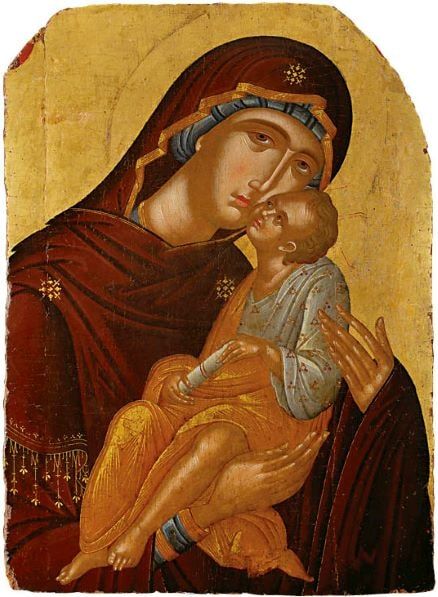How icons of Jesus Christ and Our Lady are painted
Christ stands at the center of all iconography since he was the very first icon ever drawn. Each of the other icons can be traced back to Christ in some fashion or another.

The word "icon" is Greek for "image. Christ is the first icon, the only image of God. In Colossians, we read, "He is the image of the invisible God, the firstborn of all creation." (Colossians 1:15) Therefore, all iconography is essentially Christocentric—Christ is the first icon. All the other icons are in one way or another related to Christ.
We have not seen and cannot represent God. The second commandment also forbids us to depict God. "You shall not make for yourself an idol." (Exodus 20:3-4) But when the Word of God—the Second Person of the Triune God, the Son of God—became incarnate, took on human nature and appearance, and became visible, it inevitably became imageable. The icon is the visible evidence of Christ's incarnation: "the Word became flesh and dwelt among us, and we beheld His glory" (John 1:14).
Moreover, while we depict Christ's human, visible nature, his divine nature remains incomprehensible to our mind and sight. Efforts to represent the Son of God have produced various iconographic images or types of Christ. However, all these icons have common characteristics that must be present in the iconography of Christ.
In the Bible, we do not find an exact description of Jesus' appearance. Therefore, his iconography is based on the so-called "not made with hands" images of Christ. There are several accounts in Church tradition of the miraculous imprint of Christ's face on the canvas. These images were the basis for the first icons, which have served as models for icon painters throughout the centuries. They depict Christ with dark, twisted hair, an elongated face, a slender nose, and a small beard.
Icons of Christ always have a nimbus with a cross in it. The round shape of the nimbus symbolizes eternity, while the cross in it symbolizes the suffering of Christ on the cross. The three visible ends of the cross are Greek or Church Slavonic letters meaning "present"; God, speaking to Moses from the burning thorn bush, referred to himself as "I am that I am" (Exodus 3:14). On either side of the nimbus are the letters "IC XC", an abbreviation for "Jesus Christ".
Christ is wearing the traditional male garment of the time, the himatium, or cloak, which is blue-green, and the chiton, which is purple, as an undergarment. The color of the garment reveals Christ's two natures. The royal purple symbolizes Christ's human nature, and the blue the divine nature. A ribbon over the shoulder indicates Christ's special messianic role. This garment is characteristic of the Pantocrator of Christ. Christ's right hand is usually depicted in a blessing gesture. The left hand represents either an open or closed gospel.

We can learn about Our Lady from apocryphal texts. In the iconography of Our Lady, several types can also be distinguished. However, there are characteristic details that must be present in the icons of Our Lady.
This is her mahogany or purple mafori, the traditional dress of married Jewish women of the time, decorated with a gold border and ornamental gold fringe. and three ornamental gold stars on her forehead and shoulders as a sign of her youth. The nimbus and the inscription are not missing. Most of all, Our Lady always holds the Christ Child in her arms.
The child's clothing is mostly maroon, pierced with a golden line ornament called an asista. This symbolizes the divine, uncreated light that fills and permeates everything. It also reminds us of Christ as the Light of the World.
Depending on the details, the postures, gestures, and movements of the mother and child, we recognize an iconographic type of Our Lady, a scene, or a story. However, through all the images of Our Lady runs her infinite and sincere love for her Son; her inner spiritual sorrow and contemplation, conscious of the imminent Passion of the Cross; her holy gratitude and humility before God for the honor of being on the throne of the Highest; the bosom of the Inconceivable; the staircase and door through which the Redeemer enters the world.




